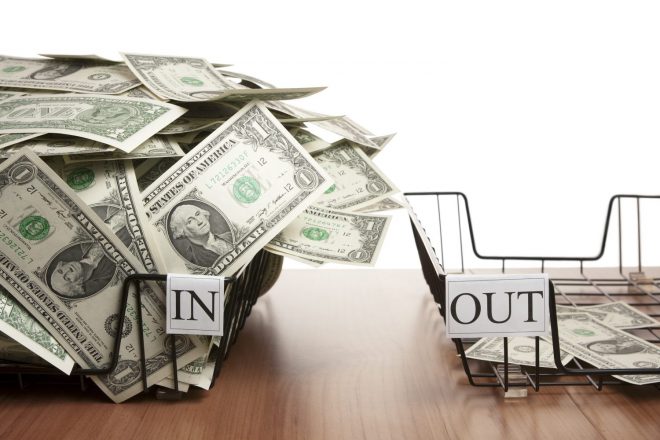
When determining the health of a business enterprise, cash flow is king. In many industries, people use it to approximate the worth of a business. In other words, businesses tend to be valued at some multiple of cash flow. Yet in personal finance, this important metric garners very little attention. The cash flow of an individual or family is just as important — and as useful — as that of a business enterprise.
What Is Cash Flow?
In its simplest form, cash flow is the difference between the ending balance of the cash you have on hand and the beginning balance of the cash you have on hand. It’s the effect of all sources of income, minus expenses. If income exceeds expenses, your cash will grow. But if expenses exceed income, your cash will shrink. For the typical individual’s situation, it can be viewed as the total of cash accounts (checking and savings) at the end of the month, minus those balances at the beginning of the month. It should be apparent that a negative cash flow can’t be sustained indefinitely.
If you have less coming in than you have going out, you’re headed for disaster. You will eventually run out of money.
It is also common knowledge that most Americans live paycheck to paycheck. This means that they have absolutely no funds left over from their pay at the end of the month. This equates to a cash flow of zero — or perhaps worse.
Manage Your Finances With This Free App
You have a cash flow of zero if you pay for all or your expenses out of your income and have nothing left over. You have a cash flow of less than zero if you pay for some of your expenses using debt, such as credit cards. A business can’t support itself indefinitely with a negative cash flow, and neither can a person. For individuals, the use of credit cards to fund expenses can camouflage the insidious effects of this situation. Many people think that they’re getting by, but in reality, they’re not.
Why Is Cash Flow Important?
Consider the habits of financially successful people — they tend to have some commonalities. For example, they tend to spend time contemplating their financial situations and have a good grasp of financial basics. Interestingly, they probably know less than you would expect about advanced investments and the strategies behind them. But they can probably tell you, with a high degree of accuracy, how much cash they have on hand and what their monthly cash flow is. These are the bread-and-butter numbers of your financial situation — those upon which all financial decisions hinge.
Going back to the business analogy, it’s common knowledge that the majority of businesses fail within the first few years of inception. Many of them fail not because they were bad ideas or because they were poorly run, but because they lack cash flow. They simply run out of money and can’t bring in enough to pay the bills. Wow.
Save Big With Discounts Available
Being relatively new and unproven, a start-up may be unable to borrow sufficient funds to grow to the point where it becomes self-sustaining. The banks look at its cash flow and run. Or perhaps the business does have a solid cash flow. It may not need investors, or else — if it does need investors in order to scale — it has a far better chance of finding them. Cash is the lifeblood of business. A positive cash flow is necessary to survive.
How to Calculate Cash Flow
While cash flow is easily defined as the change in cash accounts during a specified period, we also need to consider a couple of other pieces of information. Namely, the two things we can never escape: debt and taxes.
Debt enters into the picture because the use of debt as a substitute for cash creates an illusion that things are okay when they’re not. Expenses put onto cards are just as real as if you had paid cash for them.
Taxes enter into the picture from a timing standpoint. Many people are over-withheld. In other words, they allow the government to retain too much of their income each pay period and then receive the extra money back in the form of a windfall each spring. This distorts their true monthly cash flow picture, as there is an annual income in the form of a tax refund that needs to be factored into the monthly cash flow. An even better solution? Fix your withholding so that you don’t get a big refund!
But if you carefully consider all of your income source and subtract all of your expenses — debt and taxes included — then that is your cash flow. Use the total of your checking and savings accounts to help confirm this number. If your cash flow is positive, the money has to go somewhere. If it's negative, the money has to come from somewhere. Anything other than a cash flow that breaks exactly even should be reflected as a change in your total cash position.
Three Perspectives
Now that we have a solid understanding of this most important of financial metrics, let’s throw in a little more complexity. This may seem intimidating, but it’s actually a good idea — we’re making the information more useful!
For many people, it helps to consider their cash flow needs from several perspectives. Your cash flow needs are the total of your expenses — the amount of income that you need to cover your expenses and at least break even.
The first perspective to look at this from is a subsistence level. It considers no extra expenses, no new clothes, and no recreation. If you lost your job, what would be the minimum amount of money that you would need to continue paying your bills without going bankrupt? This is also a level that many beginning entrepreneurs focus on — the absolute least amount of money that they need to take in during a month to avoid going backwards.
The second perspective is a basic living level. While the subsistence level would have you never buying new clothes or other extra expenses, the basic level has you doing everything that you need to do. This also includes saving a sufficient amount for retirement and other financial goals. At this level, you are truly financially self-sufficient on an ongoing basis.
The third perspective is where you want to be — whatever that looks like. In addition to covering all of your needs as described in the first and second levels, it allows you to address all of your wants, whether that be traveling or saving for a vacation home or whatever else you choose. This is where the financially successful live. But they still keep the other two levels in mind, should ever need to know them.
The Bottom Line
Understanding your cash flow helps you to achieve and maintain a level of personal financial sustainability. It puts you in a position to make better financial decisions. For example, a negative cash flow should sound an alarm. It isn’t a sustainable condition.
There are really two key factors: what you make and what you spend. Adjustments to either of those factors change your cash flow and can put you in a position to live a life that’s more in line with what you want.





